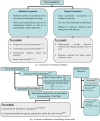Bio-inspired microfluidics: A review
- PMID: 37781135
- PMCID: PMC10539033
- DOI: 10.1063/5.0161809
Bio-inspired microfluidics: A review
Abstract
Biomicrofluidics, a subdomain of microfluidics, has been inspired by several ideas from nature. However, while the basic inspiration for the same may be drawn from the living world, the translation of all relevant essential functionalities to an artificially engineered framework does not remain trivial. Here, we review the recent progress in bio-inspired microfluidic systems via harnessing the integration of experimental and simulation tools delving into the interface of engineering and biology. Development of "on-chip" technologies as well as their multifarious applications is subsequently discussed, accompanying the relevant advancements in materials and fabrication technology. Pointers toward new directions in research, including an amalgamated fusion of data-driven modeling (such as artificial intelligence and machine learning) and physics-based paradigm, to come up with a human physiological replica on a synthetic bio-chip with due accounting of personalized features, are suggested. These are likely to facilitate physiologically replicating disease modeling on an artificially engineered biochip as well as advance drug development and screening in an expedited route with the minimization of animal and human trials.
© 2023 Author(s).
Conflict of interest statement
The authors have no conflicts to disclose.
Figures









References
-
- Koch K., Bhushan B., and Barthlott W., “Multifunctional surface structures of plants: An inspiration for biomimetics,” Prog. Mater. Sci. 54(2), 137–178 (2009). 10.1016/j.pmatsci.2008.07.003 - DOI
-
- Bhushan B., “Adhesion of multi-level hierarchical attachment systems in gecko feet,” J. Adhes. Sci. Technol. 21(12–13), 1213–1258 (2007). 10.1163/156856107782328353 - DOI
-
- Sun J., Bhushan B., and Tong J., “Structural coloration in nature,” RSC Adv. 3(35), 14862–14889 (2013). 10.1039/c3ra41096j - DOI
-
- Wilson S. J. and Hutley M. C., “The optical properties of ‘moth eye’ antireflection surfaces,” Opt. Acta 29(7), 993–1009 (1982). 10.1080/713820946 - DOI
Publication types
LinkOut - more resources
Full Text Sources
